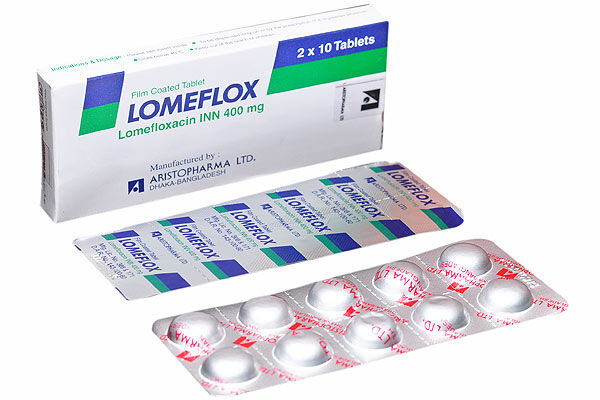Drug Nomenclature

Adverse Effects and Precautions
As for Ciprofloxacin. A relatively high incidence of phototoxic reactions has been seen in patients taking lomefloxacin. Patients should be advised to avoid exposure to sunlight during, and for a few days after, lomefloxacin therapy, and to stop the drug immediately if phototoxicity occurs. Risk of phototoxicity may be reduced by taking lomefloxacin in the evening.
Effects on the skin
Lomefloxacin has been associated with a higher incidence of phototoxic reactions, particularly in patients over 60 years of age and/or with a history of fluoroquinolone treatment; the incidence was also high when used for 30 days or longer. Experimental results suggest that use of sunscreens to protect against lomefloxacin-induced phototoxicity may be feasible.
Interactions
As for Ciprofloxacin. Lomefloxacin does not appear to interact significantly with theophylline or caffeine.
Antimicrobial Action
As for Ciprofloxacin. Most streptococci, including Streptococcus pneumoniae, are relatively resistant to lomefloxacin.
Pharmacokinetics
Lomefloxacin is rapidly and almost completely absorbed after oral doses with peak plasma concentrations of about 3 micrograms/mL occurring about 1.5 hours after a 400-mg dose. Lomefloxacin is about 10% bound to plasma proteins. It is widely distributed into body tissues including the lungs and prostate. The elimination half-life of lomefloxacin is about 7 to 8 hours, and is prolonged in patients with renal impairment. Lomefloxacin is excreted in the urine, about 65% as unchanged drug, 9% as the glucuronide, and less than 0.5% as other metabolites. Small amounts (about 10%) are also eliminated unchanged in the faeces. Negligible amounts of lomefloxacin are removed by haemodialysis or peritoneal dialysis.
Uses and Administration
Lomefloxacin is a fluoroquinolone antibacterial with actions and uses similar to those of ciprofloxacin. It is given orally for the treatment of susceptible infections, including bronchitis due to Haemophilus influenzae or Moraxella catarrhalis (Branhamella catarrhalis), and urinary-tract infections. It is also used for surgical infection prophylaxis. Lomefloxacin is given as the hydrochloride but doses are expressed in terms of the base; lomefloxacin hydrochloride 441.5 mg is equivalent to about 400 mg of lomefloxacin. The usual dose is 400 mg once daily for 10 to 14 days. A dose of 400 mg once daily for 3 days is suitable in women with acute uncomplicated cystitis. Dosage in the evening may minimise the risk of phototoxic reactions. For details of reduced doses in renal impairment, see below. A single dose of 400 mg is used for surgical infection prophylaxis, given 1 to 6 hours before the procedure. Lomefloxacin is also used topically as the hydrochloride in eye drops and ear drops containing the equivalent of 0.3% of lomefloxacin for the treatment of bacterial conjunctivitis and for the treatment of otitis externa and otitis media, respectively.
Administration in renal impairment
Dosage of lomefloxacin should be reduced in patients with renal impairment; the initial dose of 400 mg should be followed by maintenance doses of 200 mg daily in those with a creatinine clearance of 10 to 40 mL/minute per 1.73 m and in those on haemodialysis.
Preparations
Proprietary Preparations
Argentina: Okacin; Austria; Okacin; Uniquin; Belgium: Okacin; Brazil: Maxaquin; Mefloxl; Okacin; Chile: Okacin; Czech Republic: Maxaquin; Okacin; Denmark: Okacin; Finland: Okacin; France: Decalogiflox; Logiflox; Germany; Okacin; Greece: Okacin; Hong Kong; Lomeflox; Maxaquin; Okacin; Hungary: Okacin; India: Lome; Lomflox; Ontop; Israel: Okacin; Italy: Chimono; Lomebact; Maxaquin; Okacin; Uniquin; Japan: Lomeflon; Malaysia: Lomaday; Okacin; Mexico: Lomacin; Maxaquin; Philippines: Okacin; Poland: Okacin; Portugal: Basab; Floxaq-uil; Loransil; Loxina; Maxaquin; Monoquin; Okacin; Uniquin; Russia: Ksenakvin; Lomflox; Maxaquin; Okacin; South Africa; Maxaquin; Okacyn; Uniquin; Singapore: Lomflox; Okacin; Spain: Ocacin; Switzerland: Maxaquin; Okacin; Thailand: Maxaquin; Okacin; Turkey: Okacin; United Arab Emirates (UAE): Lomax; United States of America (USA): Maxaquin; Venezuela: Liexina; Loflox; Lomaday; Lomex; Maxaquin; Okacin.
Multi-ingredient
Russia: Lomecomb; Protiocomb

